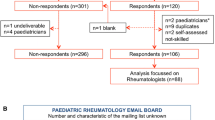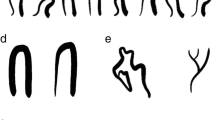Abstract
The objectives of this study were to assess a usefulness of power Doppler ultrasonography (PDU) and compare the diagnostic value of PDU to nailfold capillaroscopy (NFC) in the patients with clinically diagnosed Raynaud’s phenomenon (RP) and healthy controls. Forty-one patients with primary (n=19), secondary RP (n=22), and ten healthy controls underwent PDU and NFC examinations on the same day. Microvascularity was evaluated using PDU before and after cold challenges, and the PDU signals were qualitatively graded on a scale of 1–4. According to the change of microvascularity before and after cold challenges, the findings of PDU were classified into three groups: (1) ‘pattern I’ (normal microvascularity over grade 3 both before and after cold challenges), (2) ‘pattern II’ (decreased microvascularity to grade 1 or 2 only after cold challenge), and (3) ‘pattern III’ (decreased microvascularity of grade 1 or 2 both before and after cold challenges). PDU confirmed the presence of RP in all patients with clinically diagnosed RP and yielded a correct classification in 88.9% of the all persons analyzed (normal=100%, primary RP=89.5%, secondary RP=77.3%). The analysis was performed to assess the degree of agreement between the final diagnoses obtained by PDU and NFC. A good correlation rate was observed between PDU and NFC examinations in differentiating primary from secondary RP (Kappa=0.658, p<0.01). In conclusion, PDU examination with a cold challenge is a useful and reliable method to diagnose RP and discriminate between primary and secondary RP.

Similar content being viewed by others
References
Block JA, Sequeira W (2001) Raynaud’s phenomenon. Lancet 357:2042–2048
Wigley FM (2002) Clinical practice. Raynaud’s phenomenon. N Engl J Med 347:1001–1008
Lally EV (1992) Raynaud’s phenomenon. Curr Opin Rheumatol 4:825–836
Spencer-Green G (1998) Outcomes in primary Raynaud phenomenon: a meta-analysis of the frequency, rates, and predictors of transition to secondary diseases. Arch Intern Med 158:595–600
Herrick AL, Clark S (1998) Quantifying digital vascular disease in patients with primary Raynaud’s phenomenon and systemic sclerosis. Ann Rheum Dis 57:70–78
Naidu S, Baskerville PA, Goss DE, Roberts VC (1994) Raynaud’s phenomenon and cold stress testing: a new approach. Eur J Vasc Surg 8:567–573
Keberle M, Tony HP, Jahns R, Hau M, Haerten R, Jenett M (2000) Assessment of microvascular changes in Raynaud’s phenomenon and connective tissue disease using colour doppler ultrasound. Rheumatology (Oxford) 39:1206–1213
Martinoli C, Pretolesi F, Crespi G et al (1998) Power Doppler sonography: clinical applications. Eur J Radiol 27(Suppl 2):S133–S140
Subcommittee for Scleroderma Criteria of the American Rheumatism Association Diagnostic and Therapeutic Criteria Committee (1980) Preliminary criteria for the classification of systemic sclerosis (scleroderma). Arthritis Rheum 23:581–590
Newman JS, Laing TJ, McCarthy CJ, Adler RS (1996) Power Doppler sonography of synovitis: assessment of therapeutic response—preliminary observations. Radiology 198:582–584
Anders HJ, Sigl T, Schattenkirchner M (2001) Differentiation between primary and secondary Raynaud’s phenomenon: a prospective study comparing nailfold capillaroscopy using an ophthalmoscope or stereomicroscope. Ann Rheum Dis 60:407–409
Cohen MD (2002) Raynaud’s phenomenon. In: West SG (ed) Rheumatology secrets, 2nd edn. Hanley & Belfus, Philadelphia, pp 521–527
Fiocco U, Cozzi L, Rubaltelli L et al (1996) Long term sonographic follow-up of rheumatoid and psoriatic proliferative knee joint synovitis. Br J Rheumatol 35:155–163
Schur PH, Scmerlig RH (2003) Laboratory tests in rheumatic disorders. In: Hochberg MC, Silman AJ, Smolen JS, Weinblatt ME, Weisman MH (eds) Rheumatology, 3rd edn. Mosby, New York, pp 199–213
Cutolo M, Grassi W, Matucci Cerinic M (2003) Raynaud’s phenomenon and the role of capillaroscopy. Arthritis Rheum 48:3023–3030
Bukhari M, Herrick AL, Moore T, Manning J, Jayson MI (1996) Increased nailfold capillary dimensions in primary Raynaud’s phenomenon and systemic sclerosis. Br J Rheumatol 35:1127–1231
Acknowledgements
Sang Il Lee and Sang Yong Lee contributed equally to this work.
Author information
Authors and Affiliations
Corresponding author
Rights and permissions
About this article
Cite this article
Lee, S.I., Lee, S.Y. & Yoo, W.H. The usefulness of power Doppler ultrasonography in differentiating primary and secondary Raynaud’s phenomenon. Clin Rheumatol 25, 814–818 (2006). https://doi.org/10.1007/s10067-005-0167-0
Received:
Revised:
Accepted:
Published:
Issue Date:
DOI: https://doi.org/10.1007/s10067-005-0167-0




